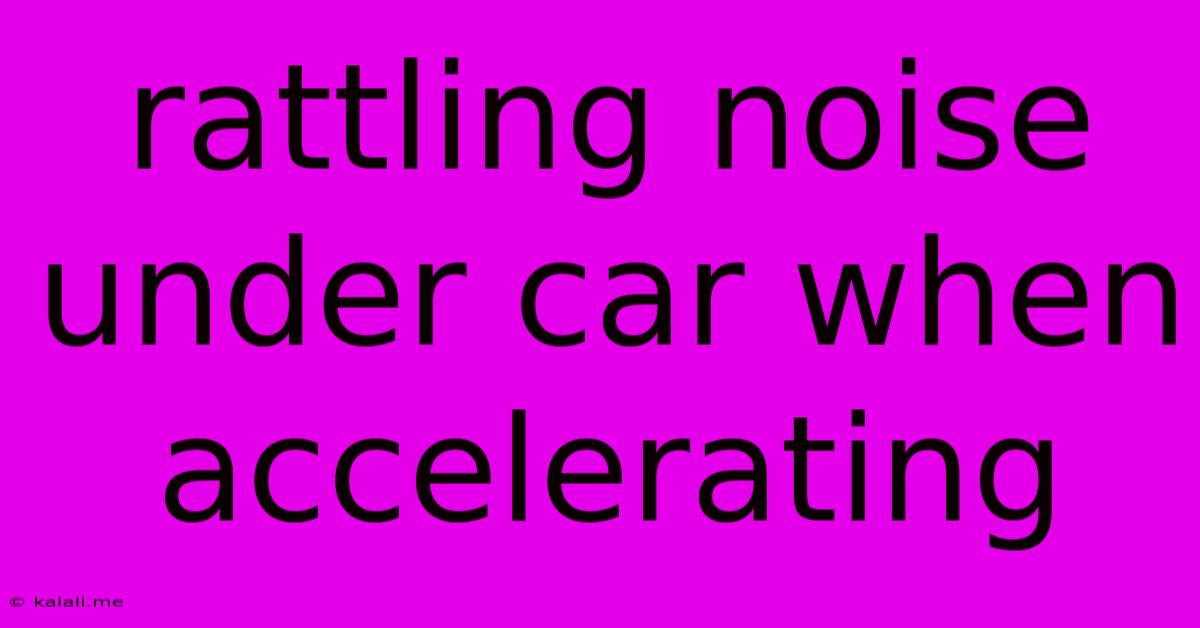Rattling Noise Under Car When Accelerating
Kalali
Jun 03, 2025 · 3 min read

Table of Contents
Rattling Noise Under Car When Accelerating: Diagnosis and Solutions
A rattling noise emanating from under your car during acceleration can be unsettling. It's a sign that something isn't quite right and could indicate a problem requiring attention. This comprehensive guide will explore common causes of this issue, helping you diagnose the problem and find solutions, saving you time and potential repair costs.
Understanding the Problem: A rattle typically points towards loose components vibrating due to engine movement or drivetrain stress during acceleration. The location of the noise – front or rear, left or right – can provide important clues to pinpoint the source.
Common Causes of Rattling Noises During Acceleration
Here are some of the most frequent culprits behind that annoying rattle:
1. Exhaust System Issues:
- Loose heat shields: These metal shields protect parts of the vehicle from exhaust heat. Loose bolts or worn-out brackets allow them to vibrate and rattle, especially when the engine is under load. This is a relatively common and easily fixable problem.
- Exhaust leaks: A leak in the exhaust system can cause a rattling sound, particularly under acceleration. Exhaust gases escaping through a crack create vibrations.
- Damaged muffler or resonator: Internal components within the muffler or resonator can loosen or break, leading to a rattling sound.
2. Drivetrain Components:
- Loose or worn CV joints: These are crucial components in front-wheel-drive vehicles, transferring power to the wheels. Worn or damaged CV joints often create a clicking or rattling noise, particularly during acceleration or turning.
- U-joints (universal joints): Found in the driveshaft of rear-wheel-drive and some all-wheel-drive vehicles, worn or damaged U-joints can produce a clicking or rattling sound.
- Loose or damaged driveshaft: A loose or damaged driveshaft can contribute to a rattling noise, especially under acceleration.
3. Suspension and Steering:
- Loose suspension components: Worn or loose control arm bushings, ball joints, or other suspension components can create a rattling noise when the suspension is stressed during acceleration. This is often accompanied by other handling issues.
- Loose heat shields (again): Heat shields aren't limited to the exhaust; some are also found near the suspension components and can also rattle.
4. Other Potential Sources:
- Loose underbody components: Various loose items under the car – such as spare tire, tools, or debris – can rattle against the chassis. A thorough inspection is necessary.
- Loose accessories: Sometimes, loose or poorly mounted accessories, such as air conditioning components or engine components, can cause rattling.
Diagnosing the Rattling Noise: A Step-by-Step Approach
- Listen Carefully: Try to pinpoint the location of the rattle: front, rear, left, or right. Note the speed and conditions under which the noise occurs (e.g., only during hard acceleration, or even during light acceleration).
- Visual Inspection: Carefully inspect the undercarriage of your vehicle. Look for any loose components, damaged parts, or debris. A jack and jack stands (used safely) will help you get a better look.
- Road Test: Ask a friend or family member to listen while you accelerate. This helps pinpoint the source better than solely listening while driving alone.
- Professional Inspection: If you can't identify the source of the rattle, it's best to take your vehicle to a qualified mechanic for a proper diagnosis and repair.
Preventive Maintenance: Reducing the Risk of Rattling Noises
Regular maintenance plays a vital role in preventing rattling issues. This includes:
- Regular inspections: Periodically check the undercarriage for loose components or signs of damage.
- Exhaust system checks: Inspect your exhaust system for leaks, loose parts, and rust.
- Drivetrain maintenance: Follow the manufacturer's recommended maintenance schedule for drivetrain components, including CV joints and U-joints.
- Suspension inspection: Regularly inspect your suspension components for wear and tear.
A rattling noise under your car during acceleration shouldn't be ignored. While some issues are minor and easily fixed, others could indicate more serious problems. By following this guide and taking prompt action, you can address the issue, ensuring your vehicle's safety and reliability. Remember, safety should always be the priority. If you're unsure, seek professional help.
Latest Posts
Latest Posts
-
Why Has Dog Not Teleported After Swimming
Jun 04, 2025
-
How To Write Actions Between Dialogue
Jun 04, 2025
-
Super Mario Brothers Wii Mushroom House Cheats
Jun 04, 2025
-
Power Series Representation Of Ln 1 X
Jun 04, 2025
-
Can You Replace Just One Rim On A Car
Jun 04, 2025
Related Post
Thank you for visiting our website which covers about Rattling Noise Under Car When Accelerating . We hope the information provided has been useful to you. Feel free to contact us if you have any questions or need further assistance. See you next time and don't miss to bookmark.